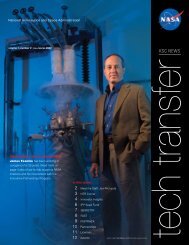2006-2007 - Kennedy Space Center Technology Transfer Office
2006-2007 - Kennedy Space Center Technology Transfer Office
2006-2007 - Kennedy Space Center Technology Transfer Office
- No tags were found...
You also want an ePaper? Increase the reach of your titles
YUMPU automatically turns print PDFs into web optimized ePapers that Google loves.
RESOLVE Projects: Lunar Water Resource Demonstration and RegolithVolatile CharacterizationIn Situ ResourceUtilization (ISRU)Oxygen ProductionTo sustain affordable human and robotic space exploration, the ability to live off theland at the exploration site will be essential. NASA calls this ability in situ resourceutilization (ISRU) and is focusing on finding ways to sustain missions first on theMoon and then on Mars.The ISRU project aims to develop capabilities to technology readiness level 6 for the Robotic LunarExploration Program and early human missions returning to the Moon. NASA is concentrating onthree primary areas of ISRU: (1) excavating, handling, and moving lunar regolith, (2) extractingoxygen from lunar regolith, and (3) finding, characterizing, extracting, separating, and storingvolatile lunar resources, especially in the permanently shadowed polar craters.To meet the challenges related to technology development for these three primary focus areas, theRegolith and Environment Science and Oxygen and Lunar Volatile Extraction (RESOLVE) projectwas initiated in February 2005, through funding by the Exploration Systems Mission Directorate.RESOLVE’s objectives are to develop requirements and conceptual designs and to performbreadboard concept verification testing of each experiment module. The final goal is to deliver aflight prototype unit that has been tested in a relevant lunar polar environment.Here we report progress toward the third primary area—creating ways to find, characterize, extract,separate, and store volatile lunar resources. The tasks include studying thermal, chemical, andelectrical ways to collect such volatile resources as hydrogen, water, nitrogen, methane, and ammonia.We approached this effort through two subtasks: lunar water resource demonstration (LWRD) andregolith volatile characterization (RVC).For the LWRD, we• developed methods for capturing and releasing hydrogen and water from a representativesample consisting of lunar simulant and representative gas mixtures,• produced a water droplet from the captured water,• reacted the water from the droplet in an electrolyzer to form hydrogen and oxygen,• designed and built an engineering breadboard unit to demonstrate hydrogen and water capturefrom a representative sample, and• performed a successful integrated test with RVC, demonstrating hydrogen and water capture, aswell as electrolysis of water to form hydrogen and oxygen.Final LWRD module.36 <strong>Space</strong>port Structures and Materials













